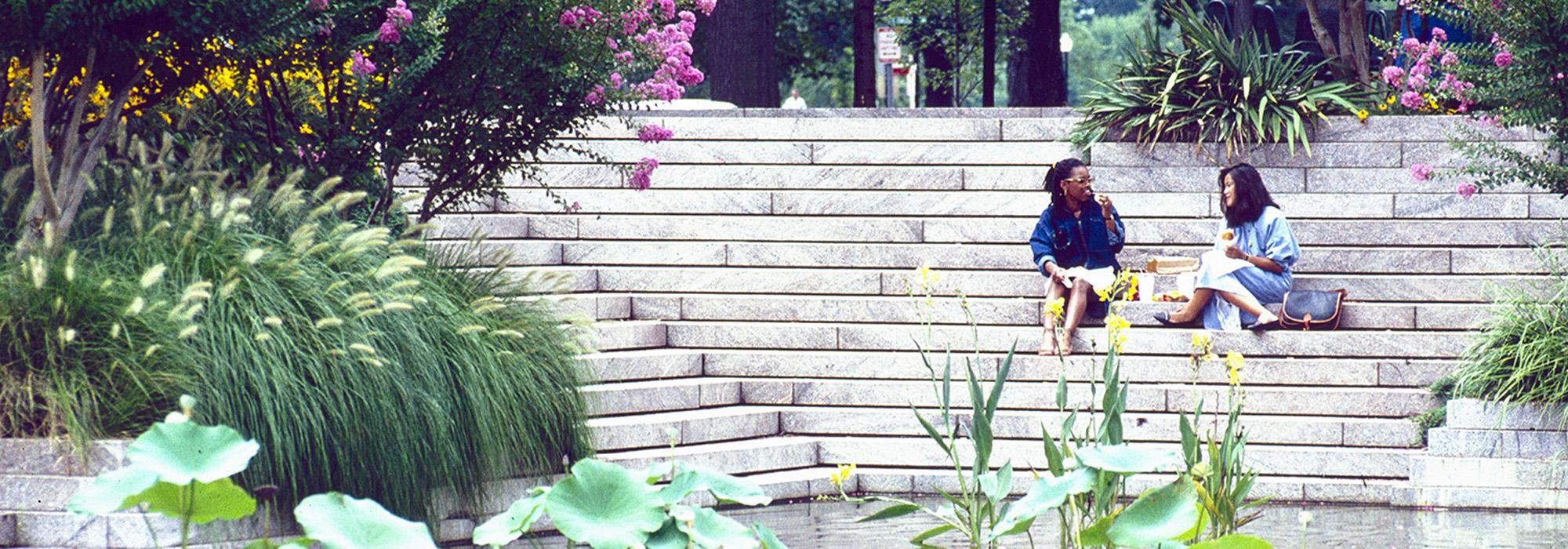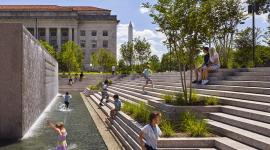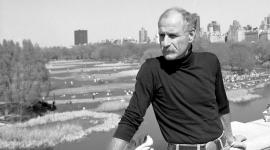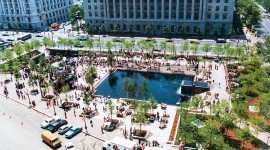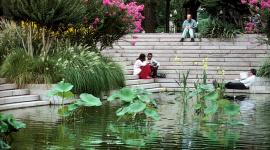Washington, D.C.’s Pershing Park put on Landslide® List of Nationally Significant At-Risk and Threatened Landscapes
Media Contact: Nord Wennerstrom | T: 202.483.0553 | M: 202.225.7076 | E: nord@tclf.org
Project is a unique effort by landscape architects M. Paul Friedberg and Oehme, van Sweden
(Washington, DC – August 5, 2015) – The Cultural Landscape Foundation TCLF) today added Pershing Park, designed by influential Modernist landscape architect M. Paul Friedberg, on the organization’s Landslide list of nationally significant at-risk and threatened landscapes. The park, located on Pennsylvania Avenue and two blocks from the White House, was commissioned by the Pennsylvania Avenue Development Corporation (PADC) and opened in 1981. Oehme, Van Sweden & Associates, Inc. did the planting design, which was installed the same year. This site, which is likely eligible to the National Register of Historic Places, is under the supervision of the National Park Service and has suffered from accrued diminished maintenance. There is now a proposal for a national World War I Memorial to be built there. Nearly all of the more than 350 first round proposed memorial designs received by the U.S. World War I Memorial Commission call for the demolition of the current park. As a recent Huffington Post article noted, the memorial’s proposed $20-25 million budget is consistent with "the demolition of the exiting landscape and the construction of a new work." The Landslide designation includes an overview of the site’s history and design.
M. Paul Friedberg, a nationally significant landscape architect, is this year’s recipient of the American Society of Landscape Architect’s (ASLA) top award, the ASLA Medal. Friedberg has already received the ASLA Design Medal, the other top award from the organization that represents the profession. He is only one of six practitioners to receive both awards in ASLA’s 116-year history. Wofgang Oehme and James van Sweden, revolutionized the practice of landscape architecture with the creation of the “New American Garden” typology. Their work is the subject of a new retrospective at the National Building Museum in Washington, DC opening October 17, 2015. This is the largest monographic landscape architecture exhibition in the museum’s history.
Pershing Park is the only project on which all of these influential professionals worked.
“Modernist landscapes, despite the wide popularity of Modernist design, remain at great risk for unsympathetic change and demolition and this current threat to Pershing Park attests to that fragility,” said TCLF President & CEO Charles A. Birnbaum. “Pershing Park deserves to be properly maintained, considered for inclusion on the National Register of Historic Places, and recognized as a rare and important example of Modernist landscape architecture on the nation’s premier ceremonial space.”
Pershing Park’s inclusion on Landslide is not a commentary by either TCLF or Mr. Friedberg on the need for or appropriateness of a national World War I memorial, the people it would honor, or the sincere intent of the Commission and its supporters. In fact, Friedberg served in the U.S. Army and was stationed in Korea, as he discusses in TCLF’s Pioneers Oral History.
About The Cultural Landscape Foundation
The Cultural Landscape Foundation (TCLF), established in 1998, is a 501(c)(3) non-profit foundation that provides people with the tools to see, understand and value landscape architecture, its practitioners, and our cultural landscape legacy in the way many people have learned to do with buildings and their designers. Through its website, lectures, outreach and publishing, TCLF broadens the support and understanding for cultural landscapes nationwide to help safeguard our priceless heritage for future generations. TCLF makes a special effort to heighten the awareness of those who impact cultural landscapes, assist groups and organizations working to increase the appreciation and recognition of cultural landscapes, and develop educational tools for young people to better connect them to their cultural landscape environs.
# # #



